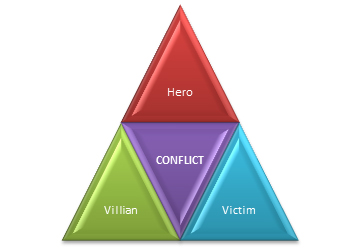The drama triangle is a tool developed by Stephen Karpman as a way to illustrate conflict resolution. While developing the theory of Transactional Analysis, Dr. Karpman created this model to show what happens during conflict as roles change as the situation unfolds.
Here’s how it works: imagine if you will, a triangle. At the top of the triangle is the rescuer. We’ll call this person A. The first leg of the triangle goes from person A to the victim. We’ll call that person B. The last part of the triangle is the persecutor. This is person C and of course, it leads back to the rescuer for our final leg of the triangle.
Now that we have all the players in place let’s see how this works. A great example of the drama triangle is the old Tom and Jerry cartoon. The victim in this case is Jerry, the mouse. The persecutor, of course is Tom the evil cat. And Spike the bulldog is naturally, the rescuer.
In the first scene, Jerry is minding his own business when all of a sudden Tom pounces. A chase ensues – around the house through the yard ultimately ending in front of the dog house. At this point, our victim looks at the bulldog in the doghouse and pleads for help. Here comes the rescuer. Spike now comes out of his doghouse and begins to beat the living daylights out of Tom. The rescuer is now the persecutor and the persecutor is the victim. After all, this poor cat is being wrapped around trees and thrown through fences. He needs help. He can’t go to Jerry because Jerry is now turned into the persecutor. Jerry is making Tom’s life miserable because he knows Spike will continue to beat Tom to within an inch of his ninth life. And on it goes, Tom chases Jerry, Jerry goes to Spike for help, Spike beats up Tom, Tom beats up Jerry and we’re back at the beginning.
At this point Tom and Jerry’s roles are interchangeable. Once Spike starts to rescue Jerry the mouse becomes the persecutor and the cat becomes the victim. There are two ways this can go: Tom can look for his own rescuer to beat up on Spike i.e spikes owner or Tom can take out his frustrations and anger on Jerry, picking on him even more evoking an even stronger response from Spike. The roles have become reversed, entangled, and obscured. Everyone’s changing roles with no end in sight. In fact, once Tom goes to spikes owner for relief the problem escalates with Spike now becoming the victim. So where does it end?
Simple, if Jerry addresses the real issue, he understands that he is not a victim. He could then take steps to deal with Tom on his own. As a victim, Jerry immediately goes into a fight or flight mode. Part of the answer may be to find out why Tom is chasing him. Part of it may be choosing to take steps so that he’s not attacked again. But once he introduces Spike into the equation, the triangle is complete and drama ensues. The goal is to not let the triangle develop. So the challenge my friends is this: when you encounter conflict, figure out if the triangle exists, if so identify your role and then develop options to avoid the drama,
